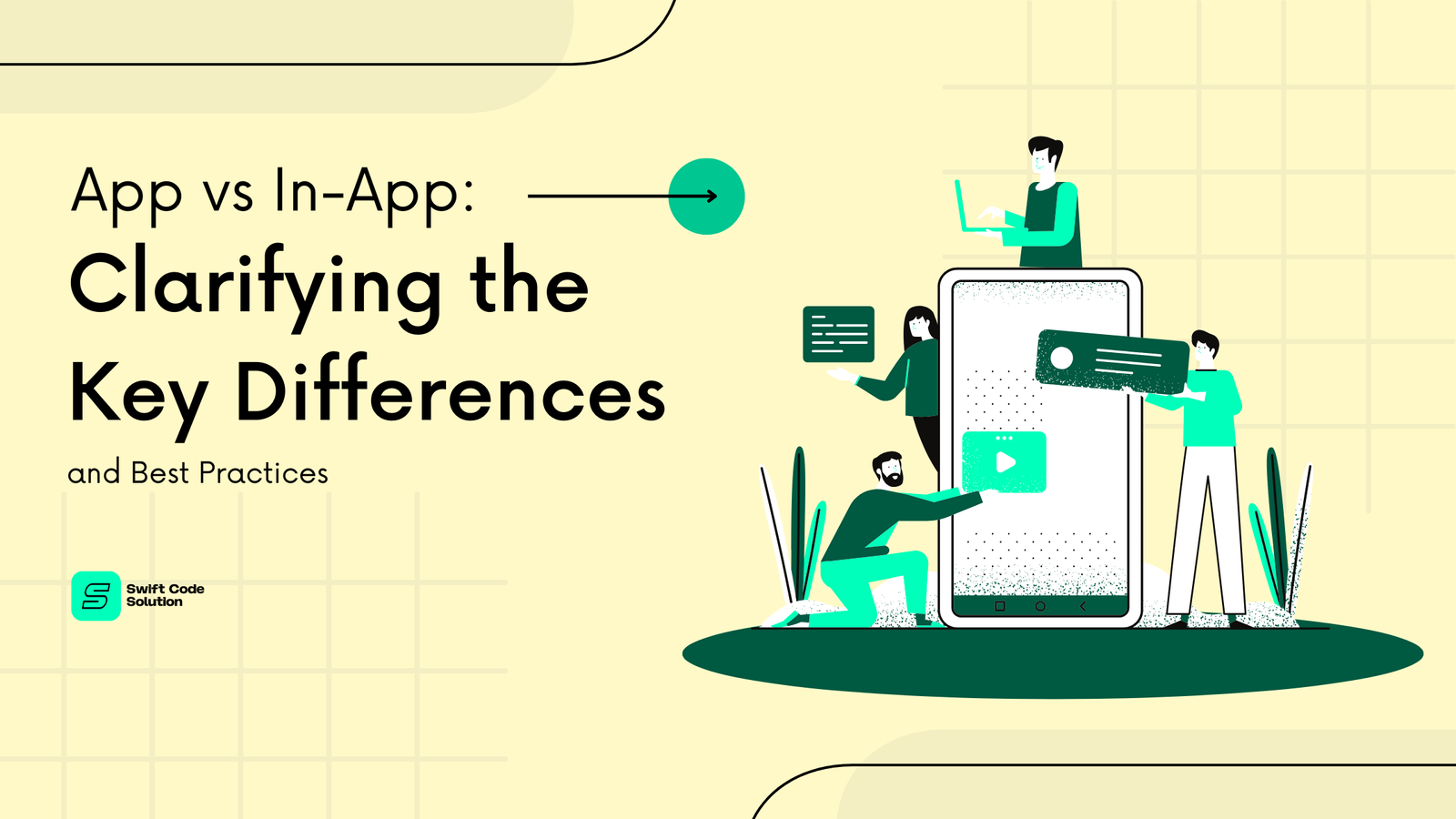What Does “App” Mean?
At its core, an “app” (short for “application”) refers to any software program designed to perform a specific task on a device, such as a smartphone, tablet, or computer. Apps can come in several types:
- Native Apps: Built for a specific platform like iOS or Android.
- Web Apps: Accessible through a web browser without the need for download.
- Hybrid Apps: A mix of both, offering a balance of web and native features.
Examples include Instagram, WhatsApp, and Spotify—these are all “apps” that you download to your phone and use for specific purposes like social networking or listening to music.
What Does “In-App” Mean?
Now, let’s talk about “in-app.” This term refers to actions or features that occur within the app itself. Whether it’s purchasing a subscription, unlocking content, or engaging with interactive elements inside the app, “in-app” denotes anything that happens while you’re actively using the app.
For example, an in-app purchase is a transaction made within the app, like buying additional lives in a mobile game or upgrading to a premium service inside a music streaming app.
Don’t Wait to Turn Your App Idea Into Reality!
Partner with our experienced team to bring your app vision to life. Get a Quote Now!
Key Differences Between “App” and “In-App”
To make it crystal clear:
- “App” refers to the entire software program—everything from its download to its installation and general use.
- “In-App” refers to specific functionalities or features inside the app, like purchases, subscriptions, or content that’s unlocked after you’ve entered the app.
It’s a simple distinction, but one that’s essential for clarity, especially when discussing mobile app features in marketing, development, or user experience contexts.
When to Use the Term “App”
Use the term “app” when you’re referring to the entire software. For instance, when you’re talking about downloading, installing, or using the overall program, “app” is the right term. Here’s how to use it correctly:
- “I need to download the app.”
- “Have you updated your app?”
- “I love using this app for my workouts.”
This is the overarching term used for the whole program or software.
When to Use the Term “In-App”
On the flip side, “in-app” should be used when referring to specific functions or actions inside the app. Common uses include in-app purchases, in-app ads, or any feature that you access or interact with while you’re inside the app. Examples:
- “I made an in-app purchase to unlock the next level in the game.”
- “You can upgrade to a premium account through the in-app settings.”
- “Check out the in-app messaging feature for better communication.”
Need Professional App Development Services?
Whether you need a native, hybrid, or web app, our experienced developers can help you build it. Contact Us Now!
Common Mistakes and How to Correct Them
Using the right term matters for clarity. Here are a few common mistakes and how to fix them:
- Mistake: “I found a great deal in app.”
- Correction: “I found a great deal on the app.” (You’re referring to something related to the app, not inside it.)
- Mistake: “You can make an on-app purchase.”
- Correction: “You can make an in-app purchase.” (Purchases happen inside the app, not on it.)
Being mindful of these distinctions will ensure you’re using the terms correctly and making your communication more precise.
Best Practices for Using App Terminology
To make sure you’re using the right terminology and communicating clearly, here are a few best practices:
- Consistency: Stick to one term—either “on app” or “in app”—throughout your article, app descriptions, or marketing materials to avoid confusion.
- Context: Pay attention to whether the action or feature you’re discussing is something that happens within the app (use “in-app”) or something related to the app but not part of it (use “on app”).
- Clarity: Be clear and concise. Instead of saying “on the app” when discussing features within it, specify that it’s an “in-app purchase” or “in-app feature” to avoid ambiguity.
By following these practices, you’ll enhance your communication and prevent misunderstandings in the tech world.
Real-World Examples of Apps and In-App Functions
Let’s look at some real-world apps and their use of “in-app” functionality:
- Instagram: The app itself allows you to share photos, watch stories, and message friends. In-app, you can also purchase filters or promote your posts through in-app purchases.
- Candy Crush: You play the game (the app) and can make in-app purchases to buy extra lives or boosters that enhance your game experience.
- Spotify: You use the Spotify app to listen to music. You can make in-app purchases to subscribe to the premium service or buy individual tracks.
App vs In-App in Marketing and Development
When marketing or developing apps, it’s crucial to understand the distinction between App vs In-App. Here’s how they matter:
- In Marketing: “App” is used when promoting the overall download and usage of the application. “In-app” is used when highlighting specific features or services available inside the app, such as exclusive content or subscription services.
- In Development: Developers focus on building the app as a whole, ensuring smooth functionality, while “in-app” features like payments or content unlocking require different technical skills and integrations.
The Role of In-App Purchases
In-app purchases are one of the most common ways developers monetize their apps. Whether it’s buying a premium feature, unlocking extra content, or making a donation, these transactions all happen within the app. This functionality has turned free-to-play games and services into profitable ventures, as users can engage with the app before deciding to spend money.
Think of mobile games, for example. Players may download the game for free, but once they’re hooked, they’re encouraged to make in-app purchases to enhance their experience. This is the essence of in-app functionality.
Want to Enhance Your App with In-App Features?
Boost your app’s engagement and functionality with in-app purchases, subscriptions, and more! Learn How We Can Help!
User Experience: App vs In-App
User experience (UX) is greatly influenced by the terms “app” and “in-app.” How users interact with the app and its in-app features can directly affect their satisfaction and engagement. By making in-app purchases, players or users feel that they are getting more value or customizing their experience.
Future Trends: App Development and In-App Innovations
As technology evolves, so too does the way we think about apps and in-app features. With the advent of augmented reality (AR), virtual reality (VR), and artificial intelligence (AI), in-app features may become even more immersive. Developers are focusing on creating apps that offer rich in-app experiences, such as shopping, gaming, and interactive services, to retain users and generate revenue.
Conclusion: Which Term Is Correct?
Ultimately, both “app” and “in-app” are correct, but they refer to different things. “App” refers to the entire software, from installation to use. “In-app,” on the other hand, focuses on specific actions or features that occur within the app itself. Understanding when to use each term will help you communicate more clearly and avoid confusion.
Your Dream App is Just One Step Away!
Our team is ready to build your custom app, designed to meet your business goals. Start Your App Development Journey Now!
FAQs
- What is the main difference between “app” and “in-app”?
- “App” refers to the entire application, while “in-app” refers to specific actions or features within the app.
- Can you make in-app purchases without downloading an app?
- No, in-app purchases require you to download and use the app itself.
- What are common mistakes when using App vs In-App?
- A common mistake is saying “in app” when you mean “on app.” For example, saying “I found a deal in app” should be “on the app.”
- Why do marketers use the term “in-app”?
- Marketers use “in-app” to refer to actions, purchases, or services within the app that can drive engagement and revenue.
- Can you have an app without any in-app functionality?
- Yes, some apps may only offer a simple experience, with no in-app purchases or features, but many apps rely on in-app functionality to enhance user engagement and profitability.







